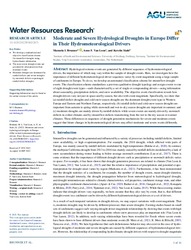Moderate and Severe Hydrological Droughts in Europe Differ in Their Hydrometeorological Drivers
DOI: https://doi.org/10.1029/2022WR032871
Persistent URL: http://resolver.sub.uni-goettingen.de/purl?gldocs-11858/10370
Persistent URL: http://resolver.sub.uni-goettingen.de/purl?gldocs-11858/10370
Supplement: https://www.bafg.de/GRDC/EN/02_srvcs/21_tmsrs/riverdischarge_node.html, https://doi.pangaea.de/10.1594/PANGAEA.887470, https://cds.climate.copernicus.eu/cdsapp#!/dataset/reanalysis-era5-land?tab=overview, http://www.hydroshare.org/resource/77114d4dfdfd4dd39e0e1d99165f27b3
Brunner, Manuela I.; Van Loon, Anne F.; Stahl, Kerstin, 2022: Moderate and Severe Hydrological Droughts in Europe Differ in Their Hydrometeorological Drivers. In: Water Resources Research, Band 58, 10, DOI: 10.1029/2022WR032871.
 |
Dokument öffnen: |
Hydrological extreme events are generated by different sequences of hydrometeorological drivers, the importance of which may vary within the sample of drought events. Here, we investigate how the importance of different hydrometeorological driver sequences varies by event magnitude using a large sample of catchments in Europe. To do so, we develop an automated classification scheme for streamflow drought events. The classification scheme standardizes a previous qualitative drought typology and assigns events to one of eight drought event types—each characterized by a set of single or compounding drivers—using information about seasonality, precipitation deficits, and snow availability. The objective event classification reveals how drought drivers vary not just in space and by season, but also with event magnitude. Specifically, we show that (a) rainfall deficit droughts and cold snow season droughts are the dominant drought event type in Western Europe and Eastern and Northern Europe, respectively; (b) rainfall deficit and cold snow season droughts are important from autumn to spring while snowmelt and wet‐to‐dry season droughts are important in summer; and (c) moderate droughts are mainly driven by rainfall deficits while severe events are mainly driven by snowmelt deficits in colder climates and by streamflow deficits transitioning from the wet to the dry season in warmer climates. These differences in sequences of drought generation mechanisms for severe and moderate events suggest that future changes in hydrometeorological drivers may affect moderate and severe events differently. Key Points:
We develop a standardized and objective classification scheme for streamflow droughts using hydroclimatic information.
The most severe drought events are governed by other processes than moderate events.
Moderate droughts are dominated by rainfall deficits and severe droughts by snowmelt deficits or prolonged rainfall deficit droughts.
Statistik:
ZugriffsstatistikSammlung:
- Geographie, Hydrologie [454]
This is an open access article under the terms of the Creative Commons Attribution License, which permits use, distribution and reproduction in any medium, provided the original work is properly cited.

